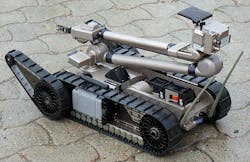iRobot lands another Navy contract for ground robots that assist bomb-disposal technicians
INDIAN HEAD, Md., 17 April 2014. U.S. Navy bomb-disposal experts are making another order to iRobot Corp. in Bedford, Mass., for manpackable robots designed to help Navy and Marine Corps. explosive ordnance disposal (EOD) technicians detect, identify, and disable explosives from safe distances.
Officials of the Naval Surface Warfare Center Indian Head Division in Indian Head, Md., announced a $59.2 million contract modification to iRobot Tuesday for the Man Transportable Robotic System (MTRS) robots, as well as depot-level repair, spare parts, and training.
The MTRS, based on the iRobot 510 PackBot unmanned ground vehicle (UGV) with electronic ordnance disposal kit, is a small robotic vehicle used by EOD technicians to conduct remote reconnaissance, render safe, and dispose of explosive devices like roadside bombs.
Since 2009 iRobot has won several Navy contracts for the MTRS. The original agreement was a $13.5 million contract in 2009. Last year the Navy awarded iRobot a $28.8 million order for MTRS bomb-disposal systems. The company also won Navy contracts 2010, 2011, and 2012 for Man-Transportable Robotic Systems.
Related: Navy awards iRobot contract modification for bomb-disposal unmanned ground vehicles
The iRobot 510 PackBot MTRS is designed to neutralize roadside bombs, car bombs, and other IEDs; screen vehicles, cargo, buildings and people for traces of explosives; search buildings, bunkers, caves, tunnels, and sewers. In addition to bomb disposal, the 510 PackBot can perform surveillance, reconnaissance and a wide range of other dangerous missions while keeping armed forces out of harm’s way.
PackBot relays real-time video, audio and sensor data while the operator stays at a safe standoff distance. The robot uses a game-style hand controller. PackBot accommodates a wide variety of interchangeable payloads that enable different missions. The robot is configured based on the needs of the mission and the operator’s preferences.
PackBot is deployable by one person in less than two minutes. No expensive, specialized equipment or vehicles are necessary; the robot loads into a MOLLE pack, the trunk of a car, or a helicopter.
Related: Army officials choose iRobot for sole-source contract to build Xm1216 small tactical robot
More than 4,500 PackBot robots have been delivered worldwide, iRobot officials say. PackBot can climb stairs, roll over rubble, and navigate narrow passages, as well as traverse rock, mud, snow, and other tough terrain at speeds to 5.8 miles per hour.
The robot is powered by iRobot Aware 2 robot intelligence software. PackBot payloads include enhanced awareness payload; three-link arm manipulator; and small arm manipulator.
Sensor payloads include explosives detection kit, longwave infrared thermal camera, and HazMat detection kit. Tool payloads include route clearance kit, mechanical cable cutters, and PAN disruptor mount.
An available mesh radio kit helps establish communications in radio-challenged environments to inspect culverts, tunnels, and other subterranean and restricted features. The radio kit can increase the communications range in urban and built-up areas and overcome lost line-of-sight communications due to low-lying areas and other terrain features.
With the 4.9 GHz mesh radio kit, PackBot uses several nodes to establish and relay communications to increase the robot’s operational range.
The PackBot 510's chassis includes an On-board computer with overheat protection; eight payload bays; global positioning system (GPS); compass; accelerometers; inclinometer; dismounted firing circuit; quickclamp fireset and auxiliary port; and rugged sealed hard case.
On the latest contract iRobot will do the work in Bedford, Mass., and will be finished in April 2015. For more information contact iRobot online at www.irobot.com, or the Naval Surface Warfare Center Indian Head Explosive Ordnance Disposal Technology Division at www.navsea.navy.mil/nswc/indianhead.

